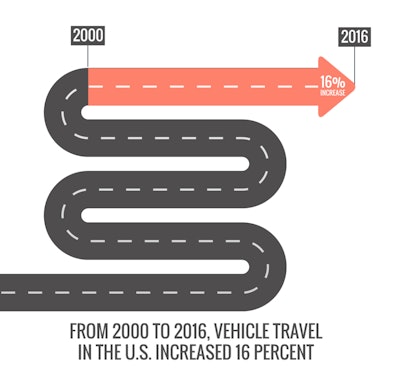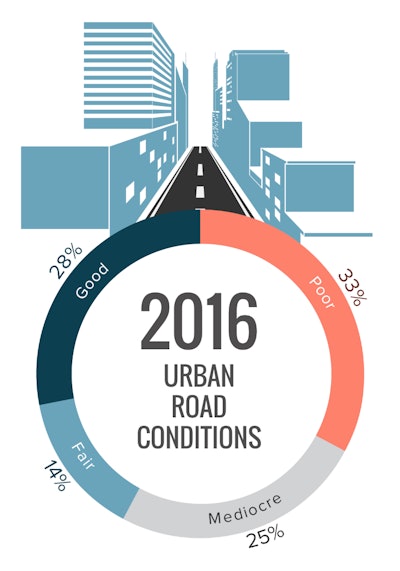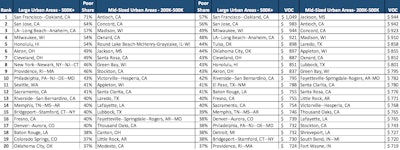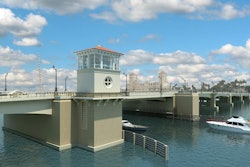
In 2016, a third of the nation’s major urban roads had pavements in substandard condition that provided an unacceptably rough ride to motorists – costing the average driver $599 annually – and leaving government entities scrambling to keep up with repairs.
Road conditions could deteriorate even further as the rate of vehicle travel continues to increase and local and state governments find they are unable to adequately fund road repairs, according to a new report from TRIP, a national transportation research group based in Washington, D.C.
“Motorists are facing a rough ride in many urban areas because of a lack of adequate funding for road repairs,” said Will Wilkins, TRIP’s executive director.
“Some states and regional governments have begun to address their needs through recent funding increases, but it will also take action by the federal government. Congress can help by fixing the federal Highway Trust Fund with a sustainable source of user-fee based revenue.”
With vehicle travel growth rates returning to pre-recession levels and large truck travel anticipated to grow significantly, wear and tear on the nation’s urban roads and highways is expected to increase the cost of needed highway repairs, TRIP says in a press release.
Vehicle miles of travel in the U.S. increased by 16 percent from 2000 to 2016 and increased by six percent in just three years from 2013 to 2016, researchers found.
And travel by large commercial trucks in the U.S. increased by 29 percent from 2000 to 2016. It’s anticipated to increase by about 56 percent from 2018 to 2045 – putting even greater stress on roadways.
“The needs of our nation’s infrastructure continue to grow; this report provides clear evidence that deteriorating roads are a strain on motorists and bad for the economy,” says Ed Mortimer, the U.S. Chamber of Commerce vice president of transportation and infrastructure. “It is past time for federal lawmakers to come together to enact a long-term infrastructure modernization plan.”
The report, “Bumpy Roads Ahead: America’s Roughest Rides and Strategies to make our Roads Smoother,” examines urban pavement conditions, transportation funding, travel trends and economic development.
Driving on deteriorated urban roads costs drivers as much as $1,049 annually, according to the report that evaluates pavement conditions in the nation’s large (500,000+ population) and mid-sized (200,000-500,000 population) urban areas and calculates the additional costs passed on to drivers as a result of driving on rough roads.
Driving on roads in disrepair increases consumer costs by increasing needed repairs, maintenance, fuel consumption and tire wear, as well as accelerating vehicle deterioration and depreciation.
The nationwide annual cost to drivers of driving on deteriorated roads totals $130 billion.

The U.S. Department of Transportation’s (USDOT) semi-annual report on the condition, use and funding needs of the nation’s surface transportation program found that the current backlog in needed road and highway rehabilitation is $419.5 billion.
The current $41 billion annual investment in maintaining the condition of roads and highways should be increased by 33 percent to $61 billion annually to improve the condition of America’s roads and highways, TRIP says.
“Drivers are paying a hefty price for our nation’s crumbling roads and bridges,” says Kathleen Bower, AAA senior vice president of public affairs and international relations.
“Those traveling daily through urban cities bear the weight of the problem – with many wasting thousands of dollars each year on rising transportation costs due to potholes and wasted fuel. AAA urges Congress and the current administration to prioritize transportation infrastructure improvements to ensure safe, efficient and reliable mobility across the United States.”
For the purposes of this report, an urban area is defined as including the major city in a region and its neighboring or surrounding suburban areas.
Pavement condition data are the latest available and are derived from the Federal Highway Administration’s (FHWA) 2016 annual survey of state transportation officials on the condition of major state and locally maintained roads and highways, based on a uniform pavement rating index.
The pavement rating index measures the level of smoothness of pavement surfaces, supplying information on the ride quality provided by road and highway surfaces.
See the report released Oct. 17 for details on the condition of the nation’s major roads, including pavement condition data for America’s most populous urban areas, recent trends in travel, the latest developments in repairing roads and building them to last longer, and the funding levels needed to adequately address America’s deteriorated roadways.
The chart below shows the top 20 large and mid-sized urban areas with the highest share of pavements on major locally and state-maintained roads and highways in poor condition, and the highest vehicle operating costs (VOC).













